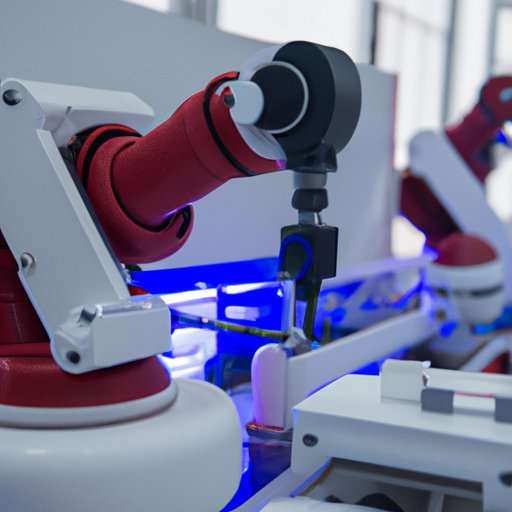Introduction
Robotics has become an integral part of modern manufacturing. In recent years, the use of robotic technology has enabled manufacturers to increase efficiency and production while reducing costs. But what exactly is robotics and what role does it play in manufacturing? This article will explore the impact of robotics on manufacturing efficiency and production, examining the types of automation and robotics used, the benefits of robotic technology, the potential for human-robot collaboration, and the regulatory implications.

Examining the Role of Robots in Automating Manufacturing Tasks
Robotics is the science of designing, constructing, and operating robots to perform tasks. It encompasses a wide range of technologies, including sensors, actuators, controllers, and vision systems. Robotics can be used to automate a variety of manufacturing tasks, such as assembly, welding, packaging, and material handling. According to a report by the International Federation of Robotics (IFR), “Robots are now being used in virtually all sectors of industry, from automotive to consumer goods, electronics, food and beverage, plastics, and metalworking.”
There are two main types of robots used in manufacturing: industrial robots and collaborative robots. Industrial robots are typically used to automate repetitive tasks, such as welding and material handling. These robots are designed to work independently and are not intended to interact with humans. Collaborative robots, on the other hand, are designed to work alongside humans, allowing them to collaborate on tasks. They are equipped with safety features that allow them to sense when they are in contact with a human and adjust their movements accordingly.
The use of robotics in manufacturing has numerous benefits. According to the IFR report, “Robots can improve quality and productivity, reduce labor costs, and increase flexibility and responsiveness to market changes.” Automating manufacturing tasks with robots can also reduce errors, improve product consistency, and increase output. Additionally, robots can be programmed to work around the clock, increasing production capacity without the need for additional staff.
Analyzing the Benefits of Robotic Technology in Manufacturing
One of the primary benefits of using robotics in manufacturing is cost savings. According to a study conducted by McKinsey, “Automation can reduce labor costs by up to 50 percent.” Automating repetitive tasks with robots can free up employees to focus on higher-value activities, such as research and development or customer service. Additionally, robots require less maintenance than traditional machines, resulting in lower operational costs.
Integrating robotics into manufacturing processes can present some challenges, however. For example, programming robots to accurately complete complex tasks can be difficult and time-consuming. Additionally, robots may require specialized infrastructure and equipment, which can be costly. Finally, there may be a need for specialized personnel to maintain and operate the robots.
Investigating the Potential for Human-Robot Collaboration in Manufacturing
Human-robot collaboration (HRC) is an emerging field of robotics that combines the strengths of both humans and robots. HRC allows humans and robots to work together to complete tasks more efficiently and effectively than either could do alone. In manufacturing, HRC can be used to increase speed, accuracy, and safety. For example, robots can be used to automate routine tasks, freeing up employees to focus on more complex tasks.
Implementing HRC in manufacturing can present some challenges, however. For example, robots may need to be trained to recognize and respond to human actions and intentions. Additionally, HRC can be expensive, as it requires specialized robots, software, and infrastructure. Finally, there may be safety concerns if the robot is not properly programmed.

Reviewing the Regulatory Implications of Robotics in Manufacturing
The use of robotics in manufacturing is subject to federal, state, and local regulations. At the federal level, the Occupational Safety and Health Administration (OSHA) regulates the use of robots in manufacturing to ensure worker safety. OSHA also requires employers to provide training for employees who work with robots. Additionally, the Environmental Protection Agency (EPA) regulates the use of robots in manufacturing to protect the environment.
At the state and local level, there may be additional regulations regarding the use of robots in manufacturing. For example, some states require employers to obtain a permit before operating a robot, while others require employers to register their robots with the state. Additionally, some localities may have restrictions on the types of robots that can be used in manufacturing.
Conclusion
Robotics has become an integral part of modern manufacturing, enabling manufacturers to increase efficiency and production while reducing costs. This article has explored the impact of robotics on manufacturing efficiency and production, examining the types of automation and robotics used, the benefits of robotic technology, the potential for human-robot collaboration, and the regulatory implications. As robotics continues to evolve, it is likely that its role in manufacturing will become even more important in the future.
(Note: Is this article not meeting your expectations? Do you have knowledge or insights to share? Unlock new opportunities and expand your reach by joining our authors team. Click Registration to join us and share your expertise with our readers.)
